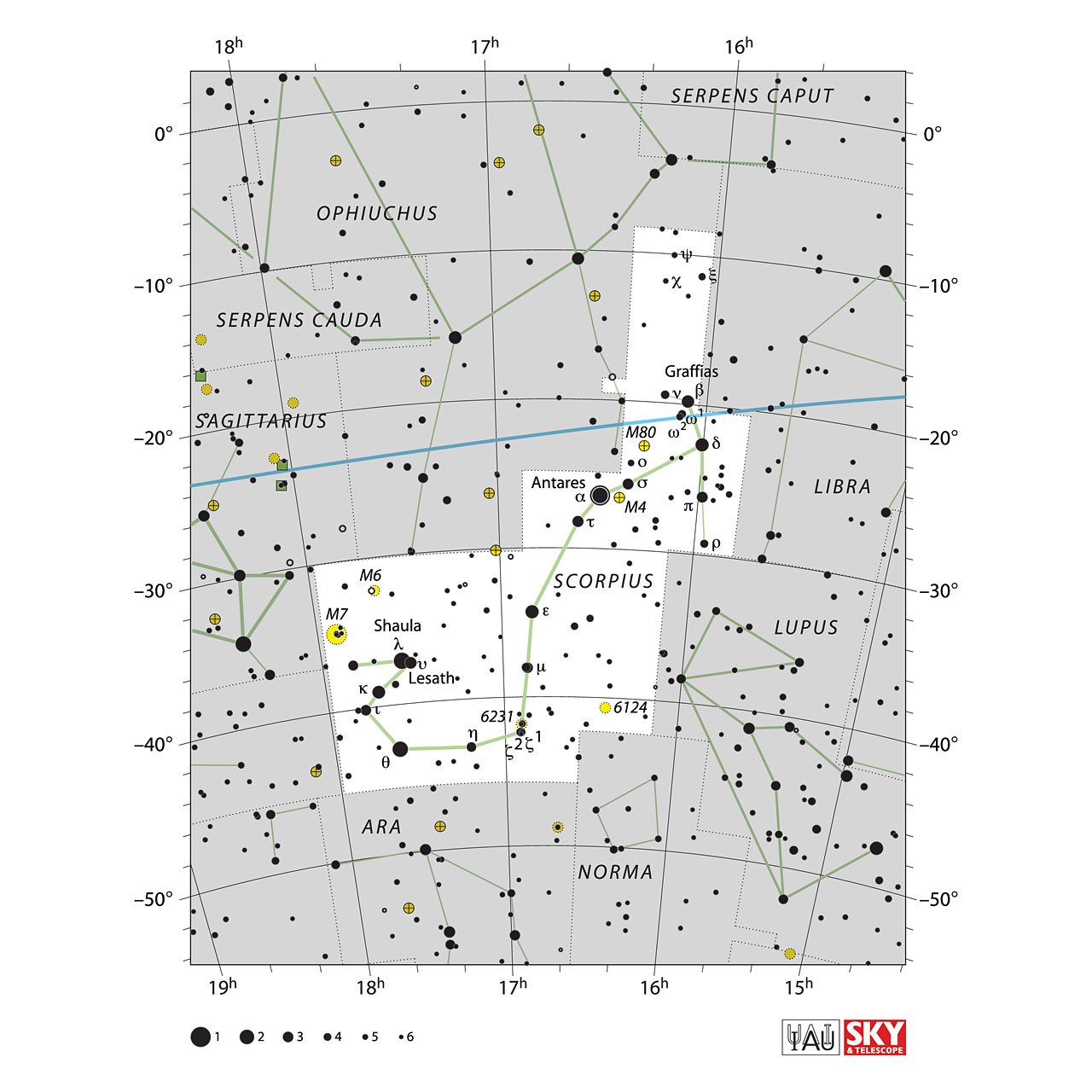Scorpius


Scorpius is a southern constellation which appears highest in the evening sky in the months around May. Scorpius is one of the 48 constellations identified by the Greek astronomer Ptolemy in the second century.
It is one of the twelve members of the zodiac, depicted as a scorpion. It should be noted that although astrologers still refer to this constellation by its old name, Scorpio, the modern constellations is called Scorpius. The Sun passes through it each year for around a week in late November.
Although the Sun spends only a few days in Scorpius each year, it is a moderately sized constellation. The northern tip of the constellation which represents the scorpion’s claws is a narrow strip of sky (see the map to the right), which the Sun takes little time to cross.
The brightest star in this sky area is Antares, which marks the scorpion’s head. South of this, the scorpion’s curving tail is marked by a string of second-magnitude stars.
The plane of the Milky Way passes through Scorpius’s southern reaches, and it is rich in star clusters, including 18 open clusters brighter than tenth-magnitude. Lying next to Sagittarius, where the Milky Way’s center lies, Scorpius also has a number of bright globular clusters.
In Greek mythology, the scorpion depicted here is said to have stung Orion. This is the famous Scorpion, which came up out of the ground and was commanded by Artimus to sting Orion, the mighty hunter, and caused him to die. That was the punishment Orion received because he had killed so many animals for no reason, except to try to impress her. Scorpio was then placed into the sky on the opposite side of the world from Orion so as to avoid any further conflict. It was also placed in the sky to remind all of us that it is okay to kill animals for food, but it is wrong to kill them just for the fun of it.
Scorpio being a Zodiac constellation is represented by the symbol ![]() and the emoji ♏.
and the emoji ♏.
In the Indian astronomy and astrology systems Scorpio is called ವೃಶ್ಚಿಕ (Vruschika).
Scorpius contains:
-
Stars
- Antares (mag 1.1)
- Shaula (mag 1.6)
- Sargas (mag 1.9)
- ε-Sco (mag 2.3)
- Dschubba (mag 2.3)
- κ-Sco (mag 2.4)
- Acrab (mag 2.6)
- Lesath (mag 2.6)
- τ-Sco (mag 2.8)
- π-Sco (mag 2.9)
- σ-Sco (mag 2.9)
- μ¹-Sco (mag 3.0)
- ι¹-Sco (mag 3.0)
- G-Sco (mag 3.2)
- η-Sco (mag 3.3)
- μ²-Sco (mag 3.5)
- ζ²-Sco (mag 3.6)
- ρ-Sco (mag 3.9)
- ω¹-Sco (mag 4.0)
- ν-Sco (mag 4.1)
- H-Sco (mag 4.2)
- N-Sco (mag 4.2)
- Q-Sco (mag 4.3)
- ω²-Sco (mag 4.3)
- ξ-Sco (mag 4.3)
-
Open Clusters
- NGC 6231 (mag 2.6)
- Messier 7 (mag 3.3)
- Messier 6 (mag 4.2)
- NGC 6281 (mag 5.4)
- NGC 6374 (mag 5.5)
- NGC 6416 (mag 5.7)
- NGC 6124 (mag 5.8)
- NGC 6322 (mag 6.0)
- NGC 6242 (mag 6.4)
- NGC 6425 (mag 7.2)
- NGC 6178 (mag 7.2)
- NGC 6259 (mag 8.0)
- NGC 6451 (mag 8.2)
- NGC 6249 (mag 8.2)
- NGC 6396 (mag 8.5)
- NGC 6192 (mag 8.5)
- NGC 6400 (mag 8.8)
- NGC 6268 (mag 9.5)
- NGC 6222 (mag 10.1)
- NGC 6216 (mag 10.1)
- NGC 6404 (mag 10.6)
- NGC 6318 (mag 11.8)
- NGC 6444
- None
-
Globular Clusters
-
Galaxy
- NGC 6000 (mag 13.0)
- IC 4596 (mag 15.0)
- None
View Scorpius in 3D 
Source: Wikipedia, in-the-sky.org
Image Courtesy: Sky&Telescope & IAU, Illustration Images linked from Urania's Mirror on Wikmedia Commons by Sidney Hall
Image Courtesy: Sky&Telescope & IAU, Illustration Images linked from Urania's Mirror on Wikmedia Commons by Sidney Hall
